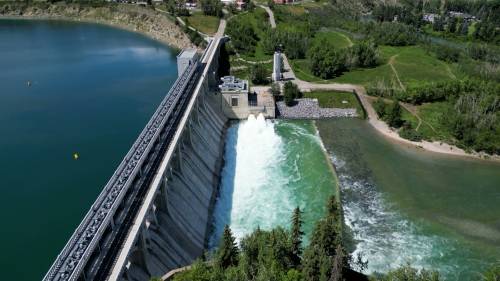The looming grey clouds over Calgary tell a story this week that many residents have dreaded since 2013. Environment Canada’s forecast calls for up to 100 millimeters of rain through Monday – numbers that have city officials mobilizing preventative measures while trying to avoid alarming the public unnecessarily.
“We’re taking this situation very seriously, but we’re not hitting the panic button,” says Sandra McKenzie, Calgary’s emergency management coordinator, during yesterday’s hastily arranged media briefing at City Hall. “This is about preparation, not prediction.”
The memories of the devastating 2013 floods that caused over $5 billion in damage across southern Alberta remain fresh for many Calgarians. Walking along the Bow River pathway yesterday morning, I encountered numerous residents discussing the weekend forecast with a mix of concern and resilience.
“You notice everyone checking the weather apps more frequently,” remarks Carol Jennings, a Sunnyside resident who lost her basement to flooding eleven years ago. “We’ve learned to watch the skies differently since 2013.”
City crews have been deploying temporary barriers along vulnerable sections of both the Bow and Elbow rivers since Thursday. The Calgary Emergency Management Agency (CEMA) has activated its operations center at Level 1, the lowest level of emergency response, primarily focused on monitoring and preparation.
Current water flow rates on the Bow River measure approximately 270 cubic meters per second – well within normal spring ranges according to data from Alberta Environment and Protected Areas. However, with saturated ground conditions from an unusually wet spring, the capacity for absorption has diminished significantly.
“The combination of forecasted rainfall and our existing soil moisture means we’re approaching this weekend with appropriate caution,” explains Dr. John Pomeroy, hydrology professor at the University of Saskatchewan and director of the Centre for Hydrology, when reached by phone. “It’s not just about total rainfall amounts, but timing, intensity, and where precisely it falls in the watershed.”
Mayor Jyoti Gondek addressed concerns during an impromptu media appearance Thursday, emphasizing the improvements made since 2013. “We’ve invested over $150 million in flood mitigation infrastructure that simply didn’t exist eleven years ago,” she noted while touring temporary berms being installed in Bowness. “From the Springbank Off-Stream Reservoir project to community-level improvements, Calgary is significantly better positioned today.”
The forecast has prompted mixed reactions among business owners in flood-prone areas. Along Memorial Drive, some shopkeepers were moving inventory to higher shelves as a precaution, while others continued operations normally.
“You can’t stop business every time rain is forecasted,” says Miguel Rojas, who owns a café in Kensington that took on water in 2013. “But you’d be foolish not to have a plan ready. We’ve got pumps, sandbags in the back, and staff know exactly what needs moving if alerts escalate.”
Alberta’s River Forecast Centre has not yet issued formal advisories for the Calgary area, though they’ve indicated they’re closely monitoring developments. Their watershed models suggest that while significant rainfall is expected, current reservoir capacities and improved infrastructure should manage the anticipated volumes.
The City of Calgary has been sending targeted communications to communities most at risk, including Bowness, Sunnyside, Inglewood, and Riverbend. Community associations have activated their own networks, demonstrating the grassroots emergency preparedness that developed following 2013.
“We’ve got neighbour-to-neighbour systems now,” explains Regan Williams, president of the Bowness Community Association. “Everything from phone trees to equipment sharing plans. That’s something positive that came from last time – we know we’re in this together.”
The city’s transportation department has identified several potential road closures that may be implemented proactively, including sections of Memorial Drive and Bow Bottom Trail. Officials stress these would be precautionary rather than reactive measures.
For newcomers to Calgary who didn’t experience the 2013 disaster, this weekend represents an introduction to the city’s complex relationship with its rivers. Social media has been filled with questions from recent arrivals about risk levels and preparation steps.
“I just moved here from Toronto last year,” says Amir Khalid, who rents in Mission. “My landlord dropped off sandbags yesterday without me even asking. That’s when I realized this was something to take seriously.”
Weather patterns can change rapidly in Alberta, a fact not lost on meteorologists monitoring the situation. The rainfall forecast has fluctuated throughout the week, with some models showing potential for the system to shift south.
“We’re dealing with probabilities, not certainties,” cautions Environment Canada meteorologist Blaine Lowry. “The forecast confidence is moderate at this point, and residents should stay informed through official channels as conditions evolve.”
As Calgarians head into an uncertain weekend, the prevailing mood seems to be one of cautious vigilance rather than fear. The city’s relationship with flood risk has evolved significantly since 2013, both in terms of infrastructure and community awareness.
The weekend ahead will test these improvements, hopefully with minimal impact. But as any long-time Calgarian will tell you, when it comes to spring weather in Alberta, it’s always best to prepare for the unexpected – while hoping those preparations prove unnecessary.






